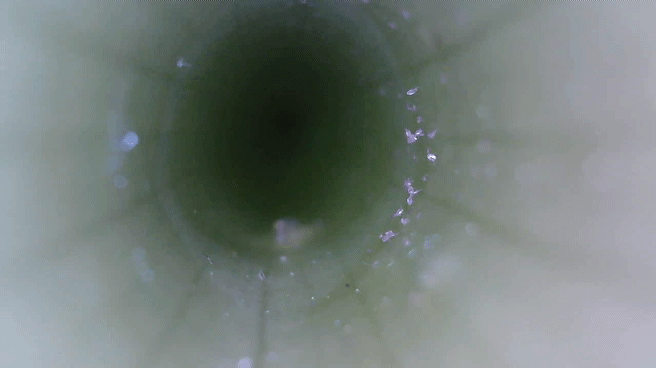March of the Slime Mites. The Blobs on Opening Day
- Scott M

- May 6, 2019
- 4 min read
Updated: Apr 1, 2020
April 14, 2019
Spring is here and that means new pitchers are opening. I wanted to see if they caught something on their first day. What I found, instead is that the blobs were already there. A new S. Luecophylla opened and there they were: blobs. The next day, they were in a just opened Judith Hindle. In both cases, they were roaming around zone 3, the glandular zone. Presumably they are waiting for dinner.

20190414_185703.mp4 20190414_185703_1.gif VideoCapture_20190414-202037.jpg
Sorry the images are blurry. The blobs are on the wall, way off of the focal point of the pencam.
How did they get there? Teleportation. Probably not. Or perhaps hitching a ride on flying insect (phoresis) Maybe. Or they just walked there. That seems obvious, climbing a pitcher seems a huge distance for a mite to walk. Or is it? A back of the envelope calculation says maybe not.
For a 1 mm critter a 12 inch pitcher is 305 mm. The blobs are around 0.5 mm long
Then a 12 inch pitcher is 610 blob body lengths.
For comparison a 6ft person, a mile (5280ft/mile) is 880 6ft human lengths.
So a 1 mm critter climbing a 2ft pitcher is 610 mm or 1220 blob body lengths. That is similar to a human walking a mile and a half, But then again, the mite is not walking a mile and a half, it's climbing a mile and a half!
Which is impressive
April 16 2019
Caught the blobs in the act of colonizing the newly opened Judith Hindle pitcher (opened that day). Spotted dozens of blobs roaming around the opening of the pitcher and in amongst the plant hairs. I haven’t observed the blobs this high up the pitcher. I assume they are coming to colonize.


Note how small these guys are relative to the pitcher.

More blobs on Judith Hindle. This is at the boarder of Zone 1 an d 2 (Just below the hairs)
20190416_182822.mp4 video of blobs around the opening of a freshly opened Judith Hindle pitcher. 20190416_182912.jpg 20190416_183153.jpg
(interestingly, on April 17, i noticed blobs roaming around the mouth of one of the older pitchers. Is it preparing to head to a newer pitcher? I haven’t followed a blob from an old pitcher to a new one. Yet. If i film this, I am putting out a DVD called “March of the Slime Mites” and I’m getting Morgan Freeman to narrate.) Note: I did not spot any blobs on the outside of the pitcher on the newly opened Leucophylla (a few days opened ) and the giant Judith Hindle (opened 2 weeks earlier).
The blobs on the newly opened pitcher raises many questions. How did they get there? I believe seeing blobs around a freshly opened pitcher implies they walked there. The fact that they are there en masse implies that they came together in sort of a mass mite migration. Or: The Blob Army is on the move! Perhaps that's just wild speculation, but we see other arthropods like ants move their colonies, so why not?
The bigger questions to me are “Why do the blobs move?” and “How do they know there is a new pitcher to move to?” These questions seem inter-related. Perhaps an answer to why move is simply that their current pitcher is getting old. Perhaps the old trap is not providing enough food for the colony and it was time to move to greener pastures (Or, conversely, the old trap was too good and the blob population got overpopulated and some of the blobs moved on)
Or the blobs could migrate because the plant tells them to. That’s not as crazy as it sounds. Plants, like animals, are a vast interconnected collection of chemical reactions. Photosynthesis is the most uniquely plant chemistry, but there are countless other important biochemical reactions going on as well. I speculate that it is the chemistry that regulates the plant’s clock that are behind the mite migration. And yes, plants can tell time. Plants have an internal clock that regulates everything from when to flower, when to hibernate and when to start new growth. Perhaps, as the new trap is opening, the plant gives off a signal to the blobs. Perhaps a chemical attractant on the newly opened pitcher to direct their journey. Or perhaps the older pitchers signal the blobs that there is a new pitcher opening soon. Or perhaps both processes are at work.
Unfortunately, I can’t see this subtle chemistry with my pencam.
Plant Circadian rhythms
April 29 2019
Also spotted blobs around on the edge of the newly opened Judith Hindle, but I've already covered opening day on JH.
The first Bugbat is opening and its a big one. It's twice the height of last year's pitcher.
And sure enough, the blobs were there on opening day, too. Unfortunately, for technical reasons, the video didn't save. (My technical difficulties were that I filled up my phone and there was no room to save the last few videos)
Since I accidentally didn't record the first day on the new Bugbat, here is day 2.after it opened. The blobs can be seen walking around the lip of the pitcher. The perspective is looking at the pitcher with the pencam parallel to the plane of the pitcher opening. The picture below puts it in perspective.
Spotted the first midge in the first new leucophylla on April 18. Presumably dropping eggs. 20190418_182458.jpg
























Comments